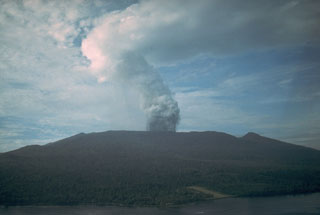Report on Karkar (Papua New Guinea) — January 1981
Scientific Event Alert Network Bulletin, vol. 6, no. 1 (January 1981)
Managing Editor: Lindsay McClelland.
Karkar (Papua New Guinea) Fumarolic activity
Please cite this report as:
Global Volcanism Program, 1981. Report on Karkar (Papua New Guinea) (McClelland, L., ed.). Scientific Event Alert Network Bulletin, 6:1. Smithsonian Institution. https://doi.org/10.5479/si.GVP.SEAN198101-251030
Karkar
Papua New Guinea
4.647°S, 145.976°E; summit elev. 1839 m
All times are local (unless otherwise noted)
"A transient increase in hydrothermal and fumarolic activity for 2-3 days at the beginning of December coincided with the onset of seasonal heavy rains. Minor geysers were observed on the floor of 1979 crater. There were voluminous emissions of white vapour from a landslide on the Bagiai side of 1979 crater floor. Fumarolic activity was strong on the W side of Bagiai Cone and on the E side of the caldera floor right up to the caldera wall. Weak to moderate vapour emissions at these localities continued for the rest of the month."
Geological Summary. Karkar is a 19 x 25 km forest-covered island that is truncated by two nested summit calderas. The 5.5 km outer caldera was formed during one or more eruptions, the last of which occurred 9,000 years ago. The steep-walled 300-m-deep, 3.2 km diameter, inner caldera was formed sometime between 1,500 and 800 years ago. Cones are present on the N and S flanks of this basaltic-to-andesitic volcano; a linear array of small cones extends from the northern rim of the outer caldera nearly to the coast. Recorded eruptions date back to 1643 from Bagiai, a pyroclastic cone constructed within the inner caldera, the floor of which is covered by young, mostly unvegetated andesitic lava flows.
Information Contacts: B. Talai and P. Lowenstein, RVO.

